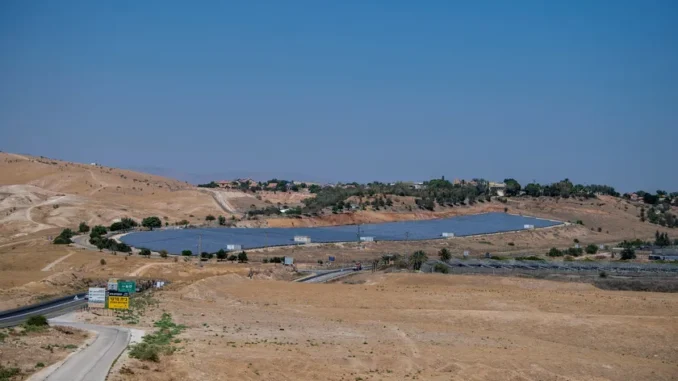Plans for 22 solar power plants in the settlements would make them a central supplier of power to Israel and the Palestinians — and increase the country’s dependence on them
Solar electricity is booming in Israel’s West Bank settlements, even as bureaucratic hurdles stall efforts to expand solar within the country.
The Civil Administration, Israel’s administrative body in the West Bank, is now moving forward with plans for 22 solar power plants in the West Bank. One plan calls for creating a plant in the Jordan Valley with greater power generation than any of the existing solar plants in Israel.
Implementing the plans would make solar power a major economic industry in the settlements and increase the country’s dependence on them.
Some major beneficiaries would be the settlements in the Jordan Valley, where the most extensive facility is scheduled to be built. According to the plan for that facility, approved about two weeks ago, it will be built on agricultural land held by the settlement of Na’amah along with another 12 settlements and cover an area of 3,250 dunams (about 800 acres).
The facility’s capacity would be 320 megawatts; the capacity of the two largest facilities that have been approved within Israel is 250 megawatts. The creation of one of those two facilities, slated to be built in Dimona, was canceled after running into obstacles.
If built, this large plant would be of substantial financial benefit to the settlements. “It’s a considerable economic resource,” David Elhayani, the head of the Jordan Valley Regional Council, told Haaretz. “We’re making our contribution as part of the effort to meet targets for the supply of alternative energy, and it also provides stability for the power supply here in the area.”
The head of the Civil Administration, Brig. Gen. Fares Atila, praised the plan, calling it “one of the most important projects recently advanced by the Civil Administration.”
The facility would presumably increase the country’s dependence on the infrastructure installed in the settlements. Currently, electricity in mainly produced outside the settlements and transmitted to them. The plan would turn the settlements into a major electricity supplier to the entire country and the Palestinian residents of the area.
According to a Civil Administration source, the Palestinians won’t be able to decide that they don’t want to buy electricity generated in the settlements. Sources involved in the energy industry raise another concern: that in the long term, the expansion of solar power in the settlements could interfere with the possibility of connecting Israel to Jordan’s power grid – something experts say is required to boost Israel’s use of renewable energy.The Energy Ministry rejected the argument that dependence on solar power in the settlements would likely prevent such a deal. The ministry said plans for energy cooperation and connecting the grids continue to progress.
Alongside the large facility, 21 smaller facilities are now planned throughout the West Bank. All told, they will cover about 7,800 dunams. While most of the solar initiatives in Israel and the West Bank are added to or integrated with existing buildings, the new projects are planned for undeveloped land.
Most of the plans for solar power in the settlements are already far into the approval process. By contrast, similar projects on the other side of the separation barrier are stalled, trapped by bureaucratic red tape.
Companies that install solar systems in Israel have long complained about delays in approving new projects, especially connecting them to communities. A significant issue is a shortage in the transmission lines that carry the electricity, particularly in undeveloped areas earmarked for new facility construction in the north and south.
The Energy Ministry says the advantage of creating the plans in the West Bank is its proximity to the center of the county, allowing it to transfer the electricity directly to areas with the highest demand. According to the Israel Electric Company, the most suitable location is the southern Jordan Valley, thanks to its proximity to Jerusalem.
The new solar plants are to be located on land declared state-owned and categorized as farmland. According to the Peace Now NGO, over 99 percent of the officially state-owned areas of the West Bank serve the settlers.
“The Palestinians would be happy to build solar facilities in Area C” – the part of the West Bank under complete Israeli civil and security control – “but it’s clear to them that Israel won’t approve them, so they don’t bother to ask,” says Tareq Abu Hamed, CEO of the Arava Institute for Environmental Studies and an expert in the field of renewable energy.
The Palestinian Authority is also encouraging the construction of solar facilities; however, its ability to issue permits is very limited. Area C, which encompasses about 60 percent of the West Bank, includes almost all the undeveloped, flat areas suitable for solar farms. “For lack of any other option, they’re choosing the land in Area B” – under Palestinian civil control but joint Israeli and Palestinian security control – “but that’s much more difficult,” says Abu Hamed.
As it encourages solar energy in the settlements, Israel frequently destroys small solar facilities that the Palestinians have created to meet local needs, mostly in the South Hebron Hills and the Jordan Valley. These small systems usually generate enough power for lighting, refrigeration, and phone charging.
According to figures collected by the UN Office for the Coordination of Humanitarian Affairs, over the past two years, 14 solar facilities built by Palestinians have been destroyed or confiscated. The West Bank is home to over 125 Bedouin or pastoralist communities – about 11,000 people – who rely on solar electricity alone.




Leave a Reply
You must be logged in to post a comment.